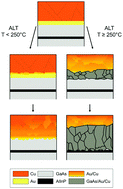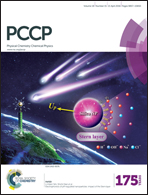Degradation mechanism(s) of GaAs solar cells with Cu contacts
Abstract
Substrate-based GaAs solar cells having a dense Au/Cu front contact grid with 45% surface coverage were exposed to accelerated life testing at temperatures between 200 and 300 °C. TEM analysis of the front contacts was used to gain a better understanding of the degradation process. During accelerated life testing at 200 °C only intermixing of the Au and Cu in the front contact occurs, without any significant influence on the J–V curve of the cells, even after 1320 h (55 days) of accelerated life testing. At temperatures ≥250 °C a recrystallization process occurs in which the metals of the contact and the GaAs front contact layer interact. Once the grainy recrystallized layer starts to approach the window, diffusion via grain boundaries to the window and into the active region of the solar cells occurs, causing a decrease in Voc due to enhanced non-radiative recombination via Cu trap levels introduced in the active region of the solar cell. To be a valid simulation of space conditions the accelerated life testing temperature should be <250 °C in future experiments, in order to avoid recrystallization of the metals with the GaAs contact layer.


 Please wait while we load your content...
Please wait while we load your content...